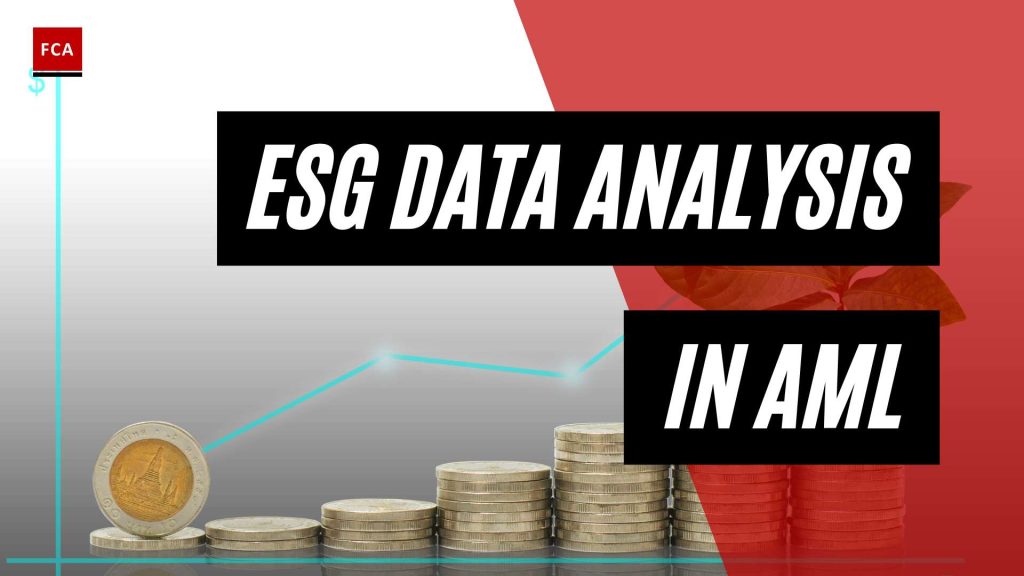The Intersection of ESG and AML
As ESG (Environmental, Social, and Governance) initiatives gain momentum, they are not only shaping corporate behavior but also impacting practices in the field of Anti-Money Laundering (AML). Understanding ESG initiatives and the impact of ESG regulations on AML practices is crucial for professionals working in compliance, risk management, anti-money laundering, and anti-financial crime.
Understanding ESG Initiatives
ESG initiatives are gaining power as a force for behavioral change among companies. They encompass a range of environmental, social, and governance factors that companies are encouraged to consider in their decision-making processes. These factors include climate change, biodiversity protection, social inequality, human rights, and more. The aim is to promote sustainable and responsible business practices that take into account the long-term impact on society and the environment.
In the context of AML, understanding ESG initiatives is important as financial institutions need to assess the ESG risks associated with their clients and transactions. By integrating ESG metrics into their risk assessment frameworks, institutions can better identify potential risks and mitigate them effectively. This integration enables a more holistic approach to risk management, aligning AML practices with broader societal and environmental goals.
The Impact of ESG Regulations on AML Practices
ESG regulations are transitioning into the risk and compliance field, influencing how organizations approach AML practices. Regulators are increasingly recognizing the importance of considering ESG factors as part of the risk management process. Financial institutions are now required to consider ESG risks and incorporate them into their AML frameworks.
The impact of ESG regulations on AML practices can be seen in various ways. Firstly, it requires financial institutions to enhance their due diligence processes by assessing the ESG risks associated with their clients and transactions. This includes evaluating the involvement of clients in activities that may have adverse environmental or social impacts.
Secondly, ESG regulations emphasize the need for robust internal controls and compliance programs. Financial institutions are expected to have adequate policies and procedures in place to address ESG risks effectively. This includes conducting ongoing monitoring and risk assessments to ensure compliance with ESG requirements.
Lastly, the integration of ESG data analysis in AML monitoring enables financial institutions to strengthen their risk-based approaches. By incorporating ESG criteria into their investigations and analysis, institutions can enhance their ability to identify potentially high-risk transactions and entities. This integration helps to align AML practices with ESG standards and requirements.
Understanding the intersection of ESG and AML is crucial for professionals in the field. By recognizing the importance of ESG initiatives and the impact of ESG regulations on AML practices, organizations can adapt their approaches to risk management and compliance. This integration not only supports the broader goals of sustainable and responsible business practices but also enhances the effectiveness of AML efforts.
Challenges in Addressing ESG Risks in AML
As the world of Anti-Money Laundering (AML) embraces the integration of Environmental, Social, and Governance (ESG) factors, financial institutions face several challenges in effectively addressing ESG risks within their AML practices. These challenges arise from regulatory pressure, customer demand, materiality, technology, expertise, and data limitations.
Regulatory Pressure
Financial institutions are experiencing increasing regulatory pressure to incorporate ESG considerations into their AML practices. ESG regulations are transitioning into the risk and compliance field, impacting how organizations approach AML practices (Thomson Reuters). Meeting these evolving regulatory requirements can be demanding, as organizations need to adapt their AML processes to incorporate ESG risk assessment and due diligence (aml regulations and esg requirements).
Customer Demand
Customer demand plays a significant role in driving the integration of ESG factors into AML practices. Increasingly, customers are demanding that financial institutions align their activities with sustainable and socially responsible values. This shift in customer expectations requires financial institutions to consider ESG criteria in their AML investigations, due diligence, and overall compliance efforts (esg due diligence in aml).
Materiality and Technology
Determining the materiality of ESG factors in the context of AML can present challenges. Financial institutions must identify and prioritize which ESG risks are most relevant to their operations and customer base. Additionally, leveraging technology to effectively analyze and manage ESG risks in AML practices is crucial. This may involve utilizing advanced data analytics and artificial intelligence tools to enhance risk-based approaches and strengthen compliance programs.
Expertise and Data Limitations
Addressing ESG risks in AML practices requires expertise in both ESG factors and AML compliance. Financial institutions need professionals who can navigate the complexities of ESG data analysis and integrate it into their AML monitoring processes. However, a shortage of individuals with expertise in both areas can pose a challenge. Furthermore, poor data quality and the lack of standardized ESG and AML metrics hinder effective risk assessment and reporting. Efforts are being made to establish consensus on standards in these areas, such as international organizations working on harmonizing ESG disclosure standards and revamping AML rules within jurisdictions (Country Risk).
Overcoming these challenges is crucial for financial institutions aiming to effectively address ESG risks in their AML practices. By staying abreast of evolving regulations, understanding customer demands, leveraging technology, and investing in the necessary expertise, financial institutions can navigate the intersection of ESG and AML to ensure compliance and mitigate risks.
Similarities Between ESG Investing and AML Analysis
When exploring the relationship between Environmental, Social, and Governance (ESG) investing and Anti-Money Laundering (AML) analysis, it becomes evident that these two fields share several similarities. Despite their distinct focuses, both ESG investing and AML analysis aim to make a positive impact and address critical issues. Additionally, there are overlapping focus areas that align with the concerns of professionals working in compliance, risk management, anti-money laundering, and anti-financial crime.
Shared Goal of Making a Positive Impact
A significant similarity between ESG investing and AML analysis is their shared goal of making the world a better place. ESG investing focuses on addressing climate change, biodiversity protection, reducing social inequality, and other environmental and social challenges. On the other hand, AML aims to prevent criminals from benefiting from illegal activities, such as money laundering (Country Risk).
By integrating ESG criteria into AML processes, financial institutions can contribute to the broader goal of ensuring responsible and sustainable practices. This alignment allows professionals in both fields to work towards a common objective of promoting ethical behavior and mitigating risks associated with illicit financial activities.
Overlapping Focus Areas
ESG investing and AML analysis also share overlapping focus areas that intersect with their respective concerns. While ESG investing traditionally centered around climate change, it has expanded to encompass a broader spectrum of environmental aspects, such as nature conservation. Additionally, ESG now places increased emphasis on social factors, including inequality and labor practices (Country Risk).
Similarly, AML analysis goes beyond financial crimes and predicate offenses to include a wide range of illegal activities. These can include offenses related to human slavery, corruption, environmental crimes like wildlife trafficking, and other social and environmental concerns. This convergence highlights the interconnectedness of various risks and emphasizes the importance of addressing them collectively.
By recognizing these overlapping areas, professionals in both ESG investing and AML analysis can collaborate to develop comprehensive risk assessment frameworks and strategies. This integration enables a more holistic approach to risk management, considering both financial and non-financial factors.
While ESG investing and AML analysis share certain similarities, it is crucial to acknowledge that each field has its own unique considerations and challenges. The lack of agreed-upon standards, potential for greenwashing, and data quality challenges pose specific hurdles that professionals must address in both ESG and AML contexts (Country Risk). By understanding these commonalities and distinguishing characteristics, professionals can further enhance their practices and contribute to a more sustainable and responsible financial landscape.
Lack of Standards and Greenwashing Risks
In the realm of ESG data analysis in AML, one significant challenge faced is the lack of standards and the potential for greenwashing and check-box exercises. These issues make it difficult to accurately assess risk factors and ensure the integrity of ESG and AML practices.
Challenges in Assessing Risk Factors
Both ESG investing and AML analysis struggle with the absence of agreed-upon standards for assessing risk factors. This lack of standardization hinders the ability to effectively compare and evaluate ESG and AML data. Efforts are being made to establish consensus on standards in these areas. For instance, organizations like the International Organization of Securities Commissions (IOSCO) are working on harmonizing ESG disclosure standards, and the European Commission is revamping rules related to AML and counter-terrorism financing within the EU (Country Risk).
Without clear standards, it becomes challenging for compliance professionals to navigate the complexities of ESG and AML analysis. The absence of a unified framework makes it harder to accurately assess risk factors and ensure the effectiveness of risk mitigation strategies.
Potential for Greenwashing and Check-Box Exercises
Both ESG investing and AML analysis are susceptible to greenwashing and check-box exercises. Greenwashing occurs when practitioners merely add third-party ESG risk scores without truly integrating ESG principles into their decision-making processes. Similarly, in AML analysis, institutions sometimes rely blindly on third-party risk classifications without fully understanding the underlying complexities.
To address these concerns, it is crucial for organizations to go beyond surface-level assessments and actively integrate ESG and AML principles into their frameworks. This requires a comprehensive understanding of the risks involved, as well as ongoing monitoring and evaluation to ensure the effectiveness of risk management strategies.
By acknowledging the lack of standards and the potential for greenwashing and check-box exercises, professionals in the field can work towards greater transparency and accountability in ESG data analysis within the context of AML. It is essential to prioritize the development of robust frameworks and methodologies that accurately assess risk factors and promote responsible practices in both ESG investing and AML analysis.
Data Quality Challenges in ESG and AML
In the realms of Environmental, Social, and Governance (ESG) analysis and Anti-Money Laundering (AML), poor data quality and the lack of standardized frameworks present significant challenges. Both ESG investing and AML analysis heavily rely on data, making data quality and consistency crucial for accurate assessments and decision-making. However, without agreed-upon standards and harmonization efforts, much of the collected data in these fields may be of limited use, particularly when assessing sovereign ESG and AML positions (Country Risk).
Poor Data Quality and Lack of Standards
The absence of standardized frameworks for data collection, reporting, and analysis poses challenges in both ESG and AML domains. In ESG analysis, data is sourced from various providers, resulting in inconsistencies and discrepancies. The lack of uniformity in ESG metrics and reporting formats makes it difficult to compare and assess the environmental, social, and governance performance of different companies or entities. Similarly, in AML analysis, the lack of standardized data formats and reporting practices hampers the effectiveness of risk assessments and compliance efforts.
To address these challenges, industry stakeholders, regulators, and organizations are actively working towards establishing consensus on standards and improving data quality. For instance, the International Organization of Securities Commissions (IOSCO) is focused on harmonizing ESG disclosure standards, while the European Commission is revamping rules related to AML and counter-terrorism financing within the European Union.
Implications for Assessing Sovereign ESG and AML Positions
The data quality challenges observed in ESG and AML analysis have specific implications when assessing the ESG and AML positions of sovereign entities. Sovereign ESG analysis involves evaluating the environmental, social, and governance factors at the country level. However, the lack of standardized data and reporting practices for sovereign entities makes it difficult to obtain comprehensive and reliable data for thorough assessments.
Similarly, in AML analysis, the effectiveness of assessing the AML positions of sovereign entities is hindered by inconsistent data quality. The lack of standardized data formats and reporting practices across jurisdictions makes it challenging to compare and evaluate the AML efforts and risks associated with different sovereign entities.
To overcome these challenges, collaboration among international organizations, governments, and regulatory bodies is crucial. Efforts should be made to establish standardized data collection methodologies, reporting formats, and disclosure requirements to enhance the quality and comparability of data for both ESG and AML analysis. This will enable more accurate assessments of sovereign ESG and AML positions, facilitating informed decision-making and risk management.
In the next section, we will explore the integration of ESG data analysis in AML monitoring, highlighting how it can enhance risk-based approaches, strengthen compliance programs, and utilize advanced technologies to address these challenges effectively.
Integrating ESG Data Analysis in AML Monitoring
To effectively address emerging trends and align with evolving ESG (Environmental, Social, and Governance) requirements, companies are integrating ESG data analysis into their Anti-Money Laundering (AML) monitoring systems. This integration allows for enhanced risk-based approaches, strengthened compliance programs, and the utilization of advanced technologies.
Enhancing Risk-Based Approaches
By incorporating ESG data analysis into AML monitoring, companies can enhance their risk-based approaches. ESG factors provide valuable insights into a company’s environmental and social impact, governance practices, and overall sustainability efforts. These factors can help identify potential risks, such as involvement with industries associated with environmental harm, human rights violations, or weak governance structures.
Integrating ESG data analysis enables AML professionals to assess the ESG performance of customers, counterparties, and transactions. This holistic view enhances risk assessments, enabling them to identify and mitigate potential money laundering risks associated with ESG factors. The integration of ESG data analysis also promotes a more comprehensive understanding of the risks and opportunities associated with specific industries or countries.
Strengthening Compliance Programs
The integration of ESG data analysis strengthens AML compliance programs by incorporating additional risk factors and criteria. Companies can establish policies and procedures that address the specific ESG risks relevant to their industry and customer base. This includes defining ESG metrics and screening processes tailored to identify potential money laundering risks linked to ESG factors.
Furthermore, ESG data analysis enables AML professionals to conduct more thorough ESG due diligence during customer onboarding and ongoing monitoring. This includes assessing the ESG performance of customers, evaluating their ESG-related policies and procedures, and monitoring their involvement in high-risk industries or activities.
Utilizing Advanced Technologies
Advanced technologies play a vital role in the integration of ESG data analysis into AML monitoring. Artificial intelligence (AI) and machine learning (ML) algorithms can be leveraged to analyze large volumes of ESG data and identify patterns, trends, and potential red flags. These technologies help automate the monitoring process, improving efficiency and effectiveness.
By utilizing advanced technologies, companies can detect suspicious transactions or activities linked to ESG factors more accurately and in real-time. The algorithms can continuously learn from patterns and anomalies, adapting to evolving trends and new risks. This enables AML professionals to stay ahead of emerging AML risks associated with ESG considerations.
The integration of ESG data analysis in AML monitoring systems provides companies with the ability to proactively manage AML risks while considering ESG factors. By enhancing risk-based approaches, strengthening compliance programs, and utilizing advanced technologies, companies can better align with ESG requirements and attract responsible investors. Effective AML monitoring contributes to a robust ESG compliance framework and helps mitigate regulatory risk exposure (HLB Global).
The Growing Significance of ESG
As ESG investing continues to gain traction globally, its significance in various industries, including anti-money laundering (AML), cannot be overlooked. This section explores the global growth of ESG investing, the pressure on companies to incorporate ESG factors, and the role of AML monitoring in ESG compliance.
Global Growth of ESG Investing
ESG investing has experienced remarkable growth in recent years. In 2020 alone, ESG investing reached a staggering $22.89 trillion globally, constituting 36% of all assets under management worldwide at the time (HLB Global). This exponential growth highlights the increasing importance of environmental, social, and governance factors in investment decision-making.
Pressure on Companies to Incorporate ESG Factors
Companies face mounting pressure from various stakeholders, including investors, regulators, and consumers, to incorporate ESG factors into their business practices. Regulators are becoming more focused on companies’ ESG practices when considering fines for AML violations (HLB Global). This pressure stems from a growing recognition of the potential risks and opportunities associated with ESG issues.
The Role of AML Monitoring in ESG Compliance
Effective AML monitoring plays a vital role in helping companies manage their regulatory risk exposure. It also contributes to building a strong ESG compliance framework, which can help attract responsible investors (HLB Global). By integrating ESG data analysis into AML monitoring systems, companies can enhance their risk-based approach and strengthen their overall compliance programs.
AML monitoring systems that utilize advanced technologies, such as artificial intelligence (AI) and machine learning (ML), can improve the efficiency and effectiveness of ESG data analysis for compliance purposes (HLB Global). These technologies enable the identification and evaluation of ESG metrics, facilitating the detection of potential risks and ensuring compliance with relevant regulations.
In summary, the significance of ESG in the business world continues to grow rapidly. Companies are under increasing pressure to incorporate ESG factors, not only to meet regulatory requirements but also to attract responsible investors. AML monitoring plays a crucial role in ESG compliance by integrating ESG data analysis, enhancing risk-based approaches, strengthening compliance programs, and utilizing advanced technologies.
ESG Litigation Risks and Concerns
As the integration of ESG data analysis in AML continues to gain momentum, companies are becoming increasingly aware of the potential litigation risks and concerns associated with ESG practices. In this section, we will explore the jurisdictional differences in ESG-related litigation risk and the top ESG concerns for companies globally.
Jurisdictional Differences in ESG-Related Litigation Risk
Companies operating in different jurisdictions face varying levels of ESG-related litigation risk. According to a report by Thomson Reuters, companies in the United States and Europe face the most ESG-related litigation risk, with the United States facing the highest risk, followed by Europe. The majority of ESG litigation events are related to employment and labor disputes (Thomson Reuters).
The differences in litigation risk can be attributed to variations in regulatory frameworks, legal systems, and societal expectations across different regions. It is essential for companies to understand the specific ESG-related legal obligations and compliance requirements in the jurisdictions where they operate to mitigate potential litigation risks. This includes keeping abreast of evolving regulations and staying proactive in addressing ESG concerns within their operations.
Top ESG Concerns for Companies Globally
Managing ESG risks and opportunities can be complex for companies, and understanding the most pressing concerns is crucial for effective risk management. According to the same Thomson Reuters report, the top three ESG concerns for companies globally are:
-
Labor Practices: Companies are increasingly under scrutiny for their treatment of employees, fair labor practices, and diversity and inclusion efforts. Ensuring fair employment practices and providing a safe and inclusive work environment are essential for addressing this concern.
-
Climate Change: The impact of climate change and the need for companies to reduce their carbon footprint have become significant priorities. Companies are expected to demonstrate their commitment to environmental sustainability through initiatives such as reducing greenhouse gas emissions, adopting renewable energy sources, and implementing sustainable business practices.
-
Corporate Governance: Strong corporate governance practices are fundamental to building trust and maintaining transparency with stakeholders. Companies need to ensure effective oversight, ethical decision-making, and accountability in their operations.
These concerns reflect the importance of managing ESG risks and aligning business practices with sustainable development goals. By addressing these concerns, companies can enhance their reputation, attract responsible investors, and contribute to a more sustainable future.
Understanding and actively managing ESG-related litigation risks and concerns is vital for companies embracing ESG principles in their AML practices. By staying informed about jurisdictional differences in litigation risk and prioritizing key ESG concerns, companies can navigate the evolving landscape of ESG integration in AML and position themselves as responsible corporate citizens.
The Financial Impact of ESG
The integration of Environmental, Social, and Governance (ESG) factors has significant financial implications for companies. Understanding the financial impact of ESG is essential for organizations seeking to incorporate these factors into their Anti-Money Laundering (AML) practices.
Outperformance of Top ESG Scoring Companies
Companies that prioritize ESG considerations have consistently outperformed their peers. According to Thomson Reuters, between January 2010 and June 2021, global top ESG scoring companies outperformed the lowest scoring companies by over 40% (Thomson Reuters). This outperformance demonstrates that ESG factors can have a positive impact on a company’s financial performance.
Investors are increasingly incorporating ESG criteria into their investment decisions. The recognition that companies with strong ESG practices are more likely to achieve long-term success has driven this shift in investment preferences. Companies that excel in ESG performance are more attractive to socially responsible investors, who prioritize sustainable and responsible business practices. As a result, these companies can benefit from increased investor interest, potentially leading to higher valuations and stock prices.
Influence on Debt Financing Costs and Credit Ratings
ESG scores can also influence debt financing costs and credit ratings. A one-point improvement in Thomson Reuters Environmental Score in 2020 was associated with a 10 basis point reduction in the cost of debt financing (Thomson Reuters). This reduction in financing costs highlights the positive relationship between strong ESG performance and favorable borrowing terms.
ESG disclosure practices can serve as a signal of quality and potential to rating agencies and debt market investors. Companies with transparent and robust ESG reporting are more likely to be viewed as reliable and trustworthy by lenders and investors. As a result, they may enjoy improved credit ratings, which can lead to lower borrowing costs and increased access to capital.
By considering ESG factors in their AML practices, organizations can align themselves with market trends and potentially benefit from the financial advantages associated with strong ESG performance. It is crucial for companies to recognize the correlation between ESG performance and financial outcomes when integrating ESG data analysis into their AML monitoring processes.
To explore how ESG factors impact other areas of AML practices, refer to our sections on ESG Litigation Risks and Concerns and The Prevalence and Importance of ESG Data.
The Prevalence and Importance of ESG Data
With the increasing focus on Environmental, Social, and Governance (ESG) factors in various industries, the prevalence and importance of ESG data have grown significantly. This section explores the rising number of ESG reports and the integration of ESG data in investment decisions and corporate strategies.
Increasing Number of ESG Reports
As of the end of 2020, there were approximately 29,000 unique ESG reports from 15,000 companies, highlighting the growing importance and prevalence of ESG data in the business world (Thomson Reuters). These reports provide insights into a company’s performance across various ESG metrics, enabling investors, stakeholders, and regulators to assess the company’s commitment to sustainable practices.
The increasing number of ESG reports reflects the growing recognition of the value that ESG factors bring to businesses. Companies are realizing the importance of transparently disclosing their ESG practices and performance to meet investor expectations and regulatory requirements. In turn, this influx of ESG data provides stakeholders with the necessary information to make informed decisions.
ESG Data in Investment Decisions and Corporate Strategies
ESG data has become an integral part of investment decisions and corporate strategies. Investors are increasingly considering ESG factors when evaluating the long-term sustainability and resilience of companies. ESG integration in investment decisions helps identify companies that align with sustainable values and have robust risk management practices.
According to Thomson Reuters, companies that ranked in the top ESG percentile consistently outperformed companies in the bottom percentile across various time periods. The global top ESG scoring companies even outperformed the lowest scoring companies by over 40% between January 2010 and June 2021. These findings emphasize the financial significance of ESG factors and their impact on investment performance.
Furthermore, ESG data informs corporate strategies by helping companies identify areas for improvement, mitigate risks, and seize opportunities related to sustainability and responsible business practices. By incorporating ESG considerations into their strategies, companies can enhance their reputation, attract investors, and align with evolving stakeholder expectations.
The growing prevalence and importance of ESG data signify the increasing recognition of the materiality of ESG factors in decision-making processes. As ESG continues to gain momentum, it becomes crucial for companies to embrace ESG data analysis for comprehensive risk management, sustainable growth, and effective compliance with regulations and industry standards.
To learn more about the integration of ESG data in Anti-Money Laundering (AML) monitoring and compliance, refer to our article on ESG integration in AML.









